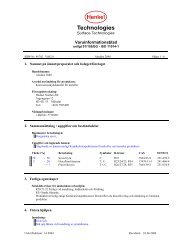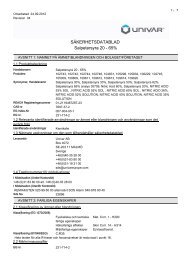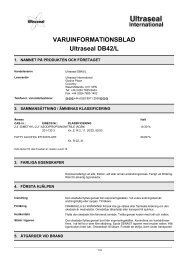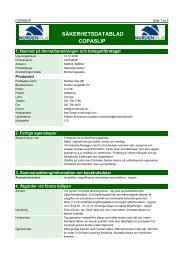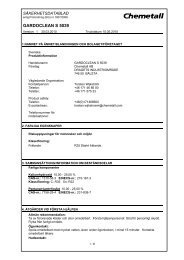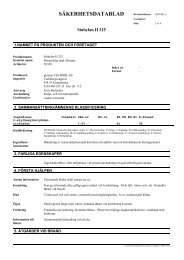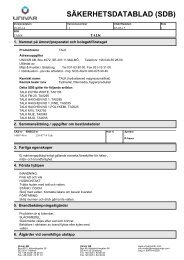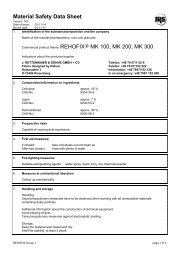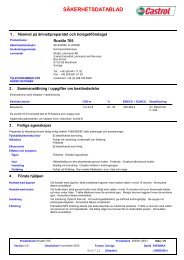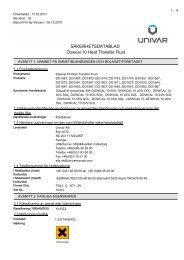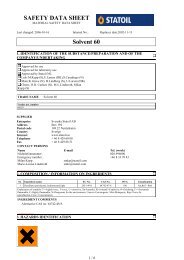[EN] - DIESEL FUEL OIL WITH RME - 2007-04-13 - IQ Logistics
[EN] - DIESEL FUEL OIL WITH RME - 2007-04-13 - IQ Logistics
[EN] - DIESEL FUEL OIL WITH RME - 2007-04-13 - IQ Logistics
You also want an ePaper? Increase the reach of your titles
YUMPU automatically turns print PDFs into web optimized ePapers that Google loves.
Safety Data Sheet<br />
Product name : <strong>DIESEL</strong> <strong>FUEL</strong> <strong>OIL</strong> <strong>WITH</strong> <strong>RME</strong><br />
Page : 1/8<br />
SDS n° :33888-33 Version :2.00 Version of :<strong>2007</strong>-<strong>04</strong>-<strong>13</strong><br />
This sheet supersedes the one dated :20<strong>04</strong>-<strong>04</strong>-16<br />
PRODUCT LABELS<br />
LABELLING (standard or EU):<br />
Symbol(s) :<br />
Concerned<br />
Symbol(s) :<br />
Contains :<br />
R-phrases :<br />
S-phrases :<br />
Xn Harmful N Dangerous for the environment.<br />
Gasoil<br />
R-40 Limited evidence of a carcinogenic effect.<br />
R-65 Harmful: may cause lung damage if swallowed.<br />
R-66 Repeated exposure may cause skin dryness or cracking.<br />
R-51/53 Toxic to aquatic organisms, may cause long-term adverse effects in the aquatic<br />
environment.<br />
S-36/37 Wear suitable protective clothing and gloves.<br />
S-62 If swallowed, do not induce vomiting: seek medical advice immediately and show<br />
the container or label.<br />
S-61 Avoid release to the environment. Refer to special instructions/Safety Data Sheets.<br />
S-2 Keep out of reach of children.<br />
TRANSPORT LABELLING: Applicable (see section 14)<br />
1. ID<strong>EN</strong>TIFICATION OF THE SUBSTANCE/PREPARATION AND OF THE COMPANY UNDERTAKING<br />
Name of the product :<br />
Product application :<br />
Supplier :<br />
<strong>DIESEL</strong> <strong>FUEL</strong> <strong>OIL</strong> <strong>WITH</strong> <strong>RME</strong><br />
Fuel for diesel engines and combustion turbines<br />
TOTAL ADDITIFS ET CARBURANTS SPECIAUX<br />
Place du Bassin<br />
69700 Givors<br />
Tel: 33 (0) 4 72 49 27 00<br />
Fax: 33 (0) 4 78 07 92 49<br />
Emergency telephones : ORFILA / Tel : 01.45.42.59.59<br />
Poisons control centers in France : - PARIS : Hôpital Fernand Widal 200, rue du<br />
Faubourg Saint-Denis 75475 Paris Cédex 10 , Tel : 01.40.05.48.48. - MARSEILLE :<br />
Hopital Salvator, 249 bd Ste Marguerite <strong>13</strong>274 Marseille cedex 5, Tel : <strong>04</strong>.91.75.25.25. -<br />
LYON : Hopital Hédouard Herriot, 5 place d'Arsonvil, 69437 Lyon cedex 3, Tel :<br />
<strong>04</strong>.72.11.69.11. - NANCY : Hopital central, 29 Av du Mal De Lattre de Tassigny, 54000<br />
Nancy, Tel : 03.83.32.36.36 or the SAMU : Tel ( 15 )<br />
See local details at end of sheet :<br />
Manufacturer :<br />
TOTAL ADDITIFS ET CARBURANTS SPECIAUX<br />
Place du Bassin<br />
69700 Givors<br />
Tel: 33 (0) 4 72 49 27 00<br />
Fax: 33 (0) 4 78 07 92 49<br />
2. COMPOSITION/INFORMATION ON INGREDI<strong>EN</strong>TS<br />
PREPARATION
Safety Data Sheet<br />
Product name : <strong>DIESEL</strong> <strong>FUEL</strong> <strong>OIL</strong> <strong>WITH</strong> <strong>RME</strong><br />
Page : 2/8<br />
SDS n° :33888-33 Version :2.00 Version of :<strong>2007</strong>-<strong>04</strong>-<strong>13</strong><br />
This sheet supersedes the one dated :20<strong>04</strong>-<strong>04</strong>-16<br />
Chemical nature :<br />
Substance composed of paraffin hydrocarbons, naphthenic, aromatic and olefin<br />
hydrocarbons, with mainly hydrocarbons from C9 to C20 (CAS: 68334-30-5).<br />
Contains also:<br />
- Vegetable oil ethers such as methyl ether from rapeseed oil =
Safety Data Sheet<br />
Product name : <strong>DIESEL</strong> <strong>FUEL</strong> <strong>OIL</strong> <strong>WITH</strong> <strong>RME</strong><br />
Page : 3/8<br />
SDS n° :33888-33 Version :2.00 Version of :<strong>2007</strong>-<strong>04</strong>-<strong>13</strong><br />
This sheet supersedes the one dated :20<strong>04</strong>-<strong>04</strong>-16<br />
5. FIRE FIGHTING MEASURES<br />
Extinguishing media :<br />
Specific fire-fighting methods :<br />
Specific hazards :<br />
Protective measures for firefighters :<br />
- suitable: Foam, CO2, powder, possibly water spray (preferably water containing a<br />
wetting agent).<br />
- not recommended: Solid water streams are prohibited as they could help to spread the<br />
flames.<br />
Simultaneous use of foam and water on the same surface is to be avoided as water<br />
destroys the foam.<br />
Cool down any tanks and surfaces exposed to fire by spraying abundantly with water.<br />
Isolate the source of the combustible product; allow to burn out under supervision or use<br />
appropriate fire extinguishers, as applicable.<br />
Arrange the machinery and equipment so as to prevent fire from spreading (retention pits<br />
and basins, syphons in the drainage system).<br />
Incomplete combustion and thermolysis may produce gases of varying toxicity such as<br />
carbon monoxide, carbon dioxide, various hydrocarbons, aldehydes and soot. These may<br />
be highly dangerous if inhaled.<br />
Use water curtains to protect the personnel.<br />
Insulated breathing apparatus must be worn in confined premises with heavy<br />
concentrations of fumes and gases.<br />
6. ACCID<strong>EN</strong>TAL RELEASE MEASURES<br />
Personal protection :<br />
After spillage / leakage :<br />
Spill cleanup methods :<br />
Prevention of secondary risks :<br />
As applicable in view of the risk of exposure, wear hydrocarbon-resistant protective<br />
clothing, a mask (if inhaling vapours is a risk), gloves, goggles, and boots (see also<br />
section 8).<br />
Design installations so as to prevent water and ground pollution.<br />
Do not allow to penetrate into sewers, rivers and ground water.<br />
In case of spillage, contact the competent authorities if the situation cannot be brought<br />
under control rapidly and efficiently.<br />
Protect environmentally sensitive areas and water resources.<br />
- Recovery: Use mechanical means such as pumps, skimmers and absorbent materials.<br />
Never use dispersing agents.<br />
Contain and collect the spilled product with sand or any other inert absorbent material.<br />
Preserve the waste in closed and sealed recipients.<br />
- Elimination: Hand over contaminated materials to an approved collector - see also<br />
section <strong>13</strong>.<br />
Do not discard to sewers.<br />
Remove all sources of ignition.<br />
7. HANDLING AND STORAGE<br />
HANDLING :<br />
Prevention of user exposure :<br />
Prevent the formation of vapours, mist and aerosols.<br />
Handle in well-ventilated premises.<br />
Keep the product away from food and beverages.<br />
Operations involving the inspection, cleaning and maintenance of storage containers<br />
require the application of strict procedures and must be entrusted to qualified specialist<br />
personnel only.<br />
DO NOT SMOKE.<br />
AVOID INHALING VAPOURS.<br />
AVOID CONTACT <strong>WITH</strong> THE SKIN AND MUCOUS MEMBRANES.<br />
NEVER ATTEMPT TO PRIME THE CONTAINER SIPHON BY SUCKING <strong>WITH</strong><br />
THE MOUTH.<br />
WEAR SUITABLE PROTECTION AND PROTECTIVE CLOTHING.
Safety Data Sheet<br />
Product name : <strong>DIESEL</strong> <strong>FUEL</strong> <strong>OIL</strong> <strong>WITH</strong> <strong>RME</strong><br />
Page : 4/8<br />
SDS n° :33888-33 Version :2.00 Version of :<strong>2007</strong>-<strong>04</strong>-<strong>13</strong><br />
This sheet supersedes the one dated :20<strong>04</strong>-<strong>04</strong>-16<br />
Prevention of fire and explosion :<br />
Precautions :<br />
STORAGE :<br />
Technical measures :<br />
Storage precautions :<br />
Incompatible products :<br />
Packaging materials :<br />
Arrange machinery and equipment so as to prevent the sheet of burning product from<br />
spreading (retention pits and basins, syphons in the water drainage system).<br />
Handle away from any source of ignition (open flame and sparks) and heat (hot manifolds<br />
or casings).<br />
Do not use compressed oxygen or air when transferring or pouring the products.<br />
OPERATE ONLY ON COLD AND DEGASSED RESERVOIRS IN V<strong>EN</strong>TILATED<br />
PREMISES (TO AVOID RISK OF EXPLOSION).<br />
Loading and unloading must be carried out at room temperature. To prevent risks related<br />
to static electricity build-up, ensure that the machinery, equipment and tanks are properly<br />
earthed, prohibit splash loadind and ensure that the product is poured slowly, particularly<br />
at the beginning of the operation.<br />
Avoid extended and repeated contact with the skin as this may cause skin conditions,<br />
which may also be aggravated by minor injuries or by contact with soiled clothing.<br />
Remove any soiled or splashed clothing immediately.<br />
After contact with skin, wash immediately with plenty of water and soap.<br />
Avoid breathing in vapours, fumes or mists.<br />
Do not eat or drink or smoke during use.<br />
Avoid contact with strong oxidising agents.<br />
Use only hydrocarbon-resistant containers, joints, pipes etc...<br />
Prevent any build-up of static electricity.<br />
Make the necessary arrangements to prevent water and soil pollution.<br />
- Suitable: Store packaged product (drums, samples, cans...) in well-ventilated areas.<br />
STORE AT ROOM TEMPERATURE, away from water, moisture, heat, and any source<br />
of ignition.<br />
- To be avoided: Do not store exposed to the elements.<br />
Dangerous reaction when in contact with strong oxidizers (herbicides etc...).<br />
- Recommended: Use only hydrocarbon-resistant containers, joints, pipes, etc.<br />
8. EXPOSURE CONTROLS/PERSONAL PROTECTION<br />
Technical measures :<br />
Occupational exposure limit :<br />
Respiratory protection :<br />
Hand protection :<br />
Eye protection :<br />
Use the product in a properly ventilated atmosphere.<br />
When working in confined spaces (tanks, containers, etc.), ensure that there is a supply of<br />
air suitable for breathing and wear the recommended equipment.<br />
In France : none.<br />
In USA, TLV-TWA (Diesel fuel / total hydrocarbons) : 100 mg/m3 - Skin<br />
In confined premises, protective respiratory equipment may need to be used.<br />
Impermeable hydrocarbon-proof gloves.<br />
Recommanded materials : PVA, Nitrile, Fluoro polymer.<br />
Goggles, in case of risk of splashing.<br />
Skin and body (other than the hands) protection :<br />
Face mask, boots, hydrocarbon-proof clothing, safety boots, as applicable.<br />
Hygienic work practices :<br />
9. PHYSICAL AND CHEMICAL PROPERTIES<br />
Appearance : Clear liquid at 20°C<br />
Avoid contact with the skin.<br />
If the product comes into contact with the skin, wash the affected area immediately and<br />
copiously with soap and water.<br />
In case of contact with eyes, wash immediately in copious amounts of water while<br />
keeping eyelids spread apart for at least 15 minutes and consult a specialist.
Safety Data Sheet<br />
Product name : <strong>DIESEL</strong> <strong>FUEL</strong> <strong>OIL</strong> <strong>WITH</strong> <strong>RME</strong><br />
Page : 5/8<br />
SDS n° :33888-33 Version :2.00 Version of :<strong>2007</strong>-<strong>04</strong>-<strong>13</strong><br />
This sheet supersedes the one dated :20<strong>04</strong>-<strong>04</strong>-16<br />
Colour :<br />
Odour :<br />
Yellow.<br />
Characteristic.<br />
Density/specific gravity : 820 - 845<br />
Temperature (°C) 15<br />
Flash point : > 55 °C (NF <strong>EN</strong> ISO 22719)<br />
Température d'auto-inflammation : > = 250 ºC (ASTM E 659)<br />
Comments on autoignition temperature :<br />
This value may be significantly lower in the case of contact with potentially catalytic<br />
materials<br />
(metals like copper, strongly divided materials)<br />
Flammability limit - lower(%) : 6<br />
Flammability limit - upper(%) : <strong>13</strong>,5<br />
Temperatures at phase change :<br />
Vapour density :<br />
Vapour pressure :<br />
Initial distillation point: >= 150 ° C<br />
Distillation range within: (150 - 380) ° C<br />
> 5 (air=1)<br />
< 100 hPa / 10 hPa<br />
Temperature (°C) 100 / 40<br />
Solubility : - in water :<br />
Practically immiscible<br />
- in organic solvents :<br />
Soluble in many common solvents.<br />
Partition coefficient (log Pow) : Log Pow = 3,9 - 6<br />
Viscosity : < 7 mm2/s à 40°C<br />
Further information :<br />
- pH: not applicable<br />
10. STABILITY AND REACTIVITY<br />
Stability :<br />
Conditions to avoid :<br />
Materials to avoid :<br />
Hazardous decomp. products :<br />
The product is stable at normal storage, handling and use temperatures.<br />
Heat, sparks, ignition points, flames, static electricity.<br />
Strong oxidising agents.<br />
Incomplete combustion and thermolysis produces potentially toxic gases such as carbon<br />
monoxide, carbon dioxide, various hydrocarbons, aldehydes and soot.<br />
11. TOXICOLOGICAL INFORMATION<br />
Acute toxicity / Local effect :<br />
Skin contact, comments:<br />
Eye contact, comments:<br />
Ingestion, comments:<br />
Not classified.<br />
CHRONIC TOXICITY OR LONG-TERM TOXICITY :<br />
Inhalation :<br />
Not classified as irritating, but may cause a burning feeling and temporary reddening.<br />
Harmful: If swallowed accidentally, the product may enter the lungs due to its low<br />
viscosity and lead to the rapid development of very serious pulmonary lesions (medical<br />
survey for 48 hours min).<br />
Vapour and spray may be irritating for the respiratory tract and for mucous membranes
Safety Data Sheet<br />
Product name : <strong>DIESEL</strong> <strong>FUEL</strong> <strong>OIL</strong> <strong>WITH</strong> <strong>RME</strong><br />
Page : 6/8<br />
SDS n° :33888-33 Version :2.00 Version of :<strong>2007</strong>-<strong>04</strong>-<strong>13</strong><br />
This sheet supersedes the one dated :20<strong>04</strong>-<strong>04</strong>-16<br />
Skin contact :<br />
Sensitization :<br />
Carcinogenicity :<br />
Prolonged or repeated contact with the skin destroys the lipoacid skin layer and may<br />
cause dermatitis with the risk of secondary allergies.<br />
Not classified as allergenic.<br />
Possible risks of irreversible effects.<br />
Certain tests on animals have shown a development of malignant skin tumours.<br />
12. ECOLOGICAL INFORMATION<br />
Comments about ecotoxicity :<br />
Mobility :<br />
Bioaccumulation :<br />
Persistence and degradability :<br />
Toxic to aquatic organisms, may cause long-term adverse effects in the aquatic<br />
environment.<br />
- Air: Having low volatility at room temperature, the product evaporates in the<br />
atmosphere and disperses to a degree, depending on local conditions.<br />
- Land: The product may infiltrate the ground.<br />
- Water: The product spreads on the surface of the water. A small amount may dissolve.<br />
The potential for bioaccumulation of the product in the environment is very low.<br />
The majority of the components of the product are intrinsically biodegradable<br />
<strong>13</strong>. DISPOSAL CONSIDERATIONS<br />
Waste disposal :<br />
Disposal of contaminated packaging :<br />
- Relevant disposal method: When using these products, product waste should<br />
theoretically only be produced accidentally. In other cases, all excess is to be recycled or<br />
burned.<br />
- Relevant disposal method: Empty packagings may contain flammable or explosive<br />
vapours.<br />
Disposal via an authorised waste contractor.<br />
14. TRANSPORT INFORMATION<br />
UN Number : 1202<br />
Proper shipping name (national) :<br />
Label for conveyance :<br />
carburant diesel<br />
Road (ADR) / Rail (RID) :<br />
Class :<br />
Code de classification :<br />
Class 3: Flammable liquids.<br />
F1<br />
Hazard Label(s) : 3<br />
Hazard identification number : 30<br />
Packing Group :<br />
Transport by barge (ADNR) :<br />
III<br />
Class : 3
Safety Data Sheet<br />
Product name : <strong>DIESEL</strong> <strong>FUEL</strong> <strong>OIL</strong> <strong>WITH</strong> <strong>RME</strong><br />
Page : 7/8<br />
SDS n° :33888-33 Version :2.00 Version of :<strong>2007</strong>-<strong>04</strong>-<strong>13</strong><br />
This sheet supersedes the one dated :20<strong>04</strong>-<strong>04</strong>-16<br />
Code de classification :<br />
F1<br />
Hazard Label(s) : 3<br />
Packing Group :<br />
Marine (IMO-IMDG) :<br />
III<br />
Class : 3<br />
Hazard Label(s) : 3<br />
Safety card : FS 3-07<br />
Marine pollutant :<br />
Packing Group :<br />
Air (ICAO/IATA) :<br />
No.<br />
III<br />
Class : 3<br />
Hazard Label(s) : 3<br />
Packing Group :<br />
III<br />
15. REGULATORY INFORMATION<br />
Symbol(s) :<br />
Symbol(s) :<br />
Contains :<br />
Risk phrases :<br />
Safety phrases :<br />
EU directives :<br />
Social Security code :<br />
Xn Harmful N Dangerous for the environment.<br />
Gasoil<br />
R-40 Limited evidence of a carcinogenic effect.<br />
R-65 Harmful: may cause lung damage if swallowed.<br />
R-66 Repeated exposure may cause skin dryness or cracking.<br />
R-51/53 Toxic to aquatic organisms, may cause long-term adverse effects in the aquatic<br />
environment.<br />
S-36/37 Wear suitable protective clothing and gloves.<br />
S-62 If swallowed, do not induce vomiting: seek medical advice immediately and show<br />
the container or label.<br />
S-61 Avoid release to the environment. Refer to special instructions/Safety Data Sheets.<br />
S-2 Keep out of reach of children.<br />
Hazardous preparations directive 1999/45/EC modified (Directive 2001/60/EC).<br />
Table of occupational illnesses and diseases No. 4 bis<br />
16. OTHER INFORMATION<br />
Explanations of R-phrases in section 2 :<br />
R-40 Limited evidence of a carcinogenic effect.<br />
R-65 Harmful: may cause lung damage if swallowed.<br />
R-66 Repeated exposure may cause skin dryness or cracking.<br />
R-51/53 Toxic to aquatic organisms, may cause long-term adverse effects in the aquatic<br />
environment.
Safety Data Sheet<br />
Product name : <strong>DIESEL</strong> <strong>FUEL</strong> <strong>OIL</strong> <strong>WITH</strong> <strong>RME</strong><br />
Page : 8/8<br />
SDS n° :33888-33 Version :2.00 Version of :<strong>2007</strong>-<strong>04</strong>-<strong>13</strong><br />
This sheet supersedes the one dated :20<strong>04</strong>-<strong>04</strong>-16<br />
RECOMM<strong>EN</strong>DED USES AND RESTRICTIONS ON USE :<br />
The product is to be used exclusively for the production as fuel for diesel engines and<br />
combustion turbines<br />
Revision date: <strong>2007</strong>-<strong>04</strong>-<strong>13</strong><br />
Supersedes the data sheet of: 20<strong>04</strong>-<strong>04</strong>-16<br />
* Information revised since the previous version of the SDS :<br />
This safety data sheet serves to complete but not to replace the technical product sheets. The information contained herein is given in good<br />
faith and is accurate to the best of knowledge at the date indicated above.It is understood by the user that any use of the product for<br />
purposes other than those for which it was designed entails potential risk.The information given herein in no way dispenses the user from<br />
knowing and applying all provisions regulating his activity.The user bears sole liability for the precautions required when using the<br />
product.The regulatory texts indicated herein are intended to aid the user to fulfil his obligations. This list is not to be considered complete<br />
and exhaustive.It is the user's responsibility to ensure that he is subject to no other obligations than those mentioned.


![[EN] - DIESEL FUEL OIL WITH RME - 2007-04-13 - IQ Logistics](https://img.yumpu.com/27279656/1/500x640/en-diesel-fuel-oil-with-rme-2007-04-13-iq-logistics.jpg)
